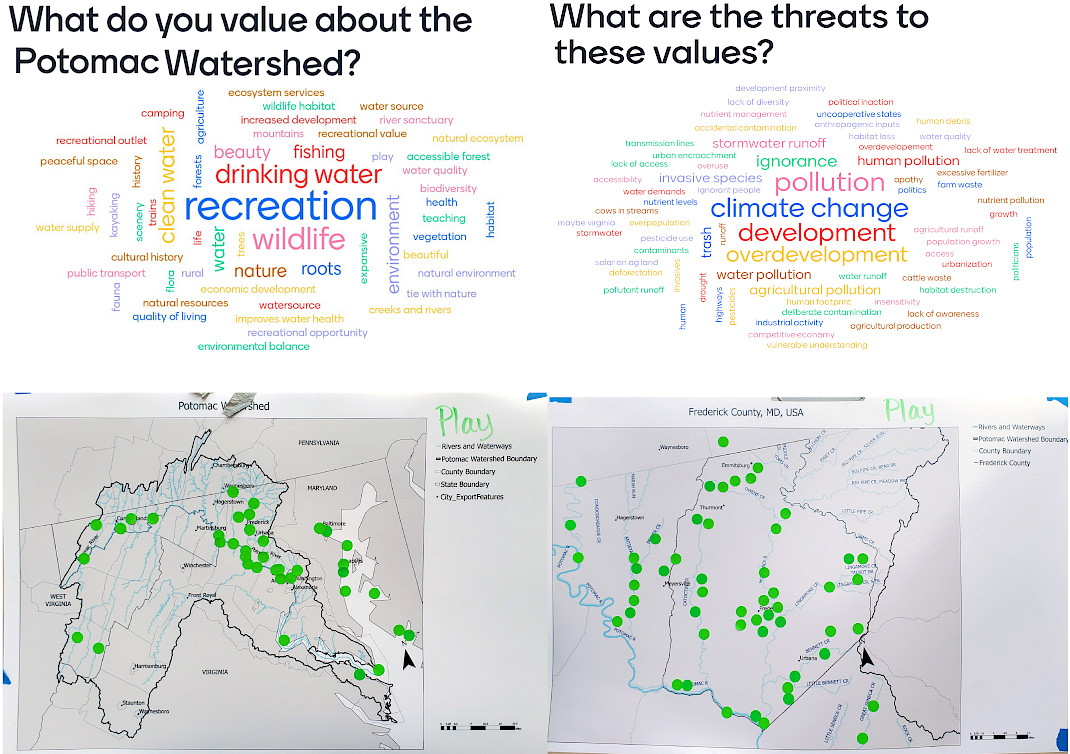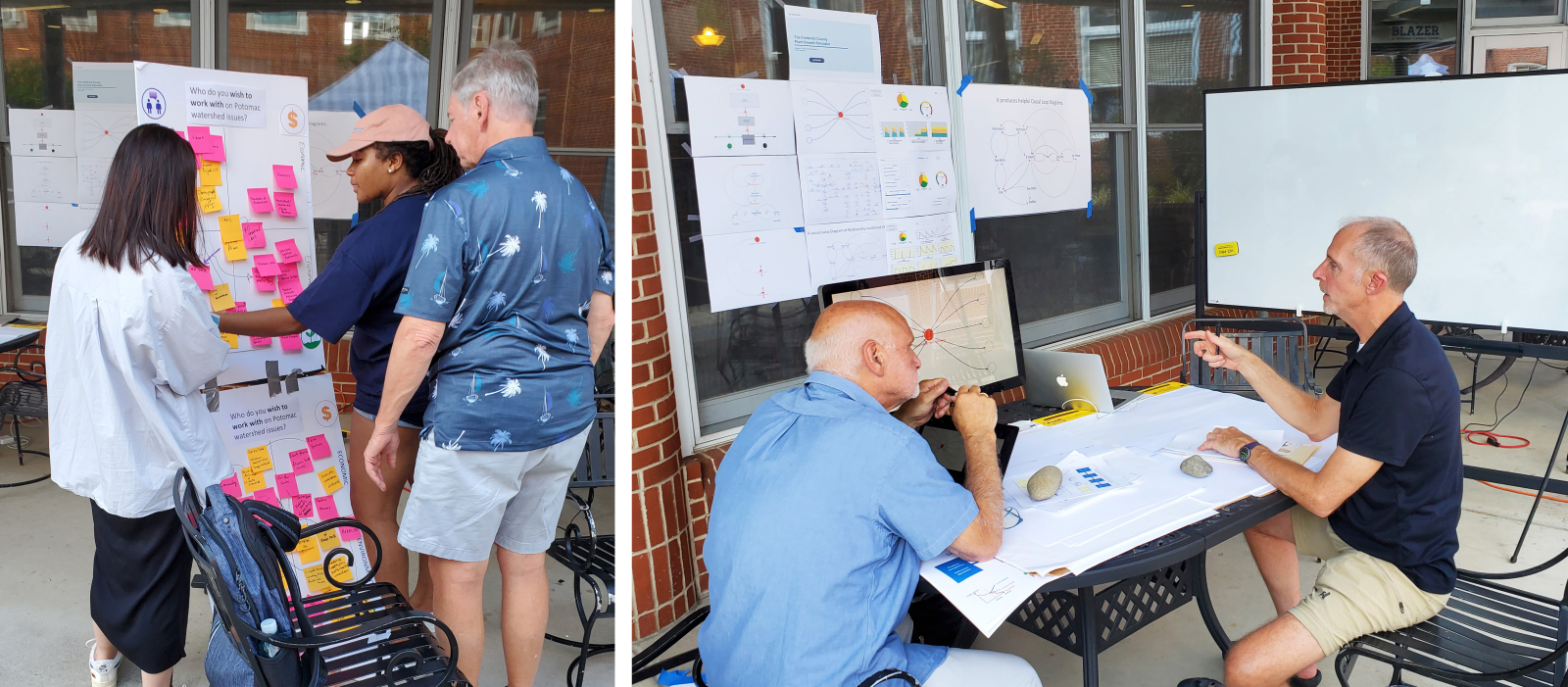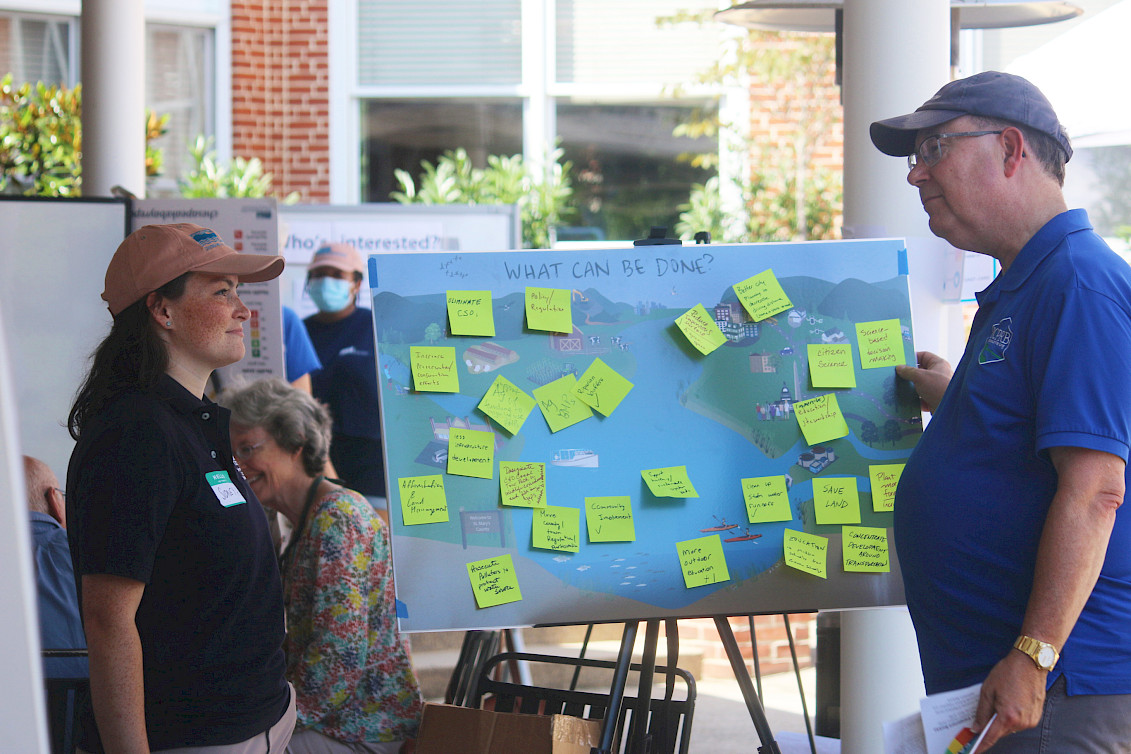Generating Collective Knowledge at the Potomac Open House
Anna Calderón, Nick An, Pheej Lauj (Pheng Lor), Lawren Caldwell, Sidney Anderson, and Lili Badri ·On a sunny Thursday in July, over 40 community members throughout the greater Frederick County in Maryland participated in the very first Potomac Watershed Open House, hosted by the Integration and Application Network (IAN), University of Maryland’s Center for Environmental Science (UMCES) and the Center for Coastal and Watershed Studies, Hood College. This event signified both positive potential and a collaborative approach to the future of coastal and ocean management along the Chesapeake Bay, and beyond. Among these community members were governmental and organizational staff, representatives from the wildlife and recreation industries, as well as academics and community-led conservation groups. Many attendees approached our welcome booth with the question “So what’s this open house about?” and left with more than they bargained for!
The brief and simple response to that question was, “You. You are what this open house is about.” The UMCES team hosted the Potomac Watershed Open House with it being one of three open houses in mind. Currently in the works, the Shenandoah and St. Mary’s counties are where similar open house convening will take place to gather stakeholders and community members who care about the Potomac River and Watershed. To expand on the recently released 2021 Chesapeake Bay & Watershed Report Card, the intention of the open house is to co-develop with the community a socio-environmental report card through the assessment of ecological, economic, and societal indicators for the Potomac Watershed.

The welcome table was the first stop for community members where they were given informational materials about the event and about IAN.
Many attendees were interested to learn about how our project falls into a larger project called COAST (Coastal Ocean Assessment for Sustainability and Transformation) Card. COAST Card is an international, transdisciplinary project with 5 partners around the globe. In each location–the USA, Japan, Norway, India and the Philippines–there is a team of researchers working toward the same goals: monitor, forecast, and report on the effectiveness of management decisions on coastal and ocean sustainability. As each group engages with their local communities and implements different methods of engagement, they share the results of that effort with their international collaborators, allowing each team to learn from the others as the project progresses. As representatives of the USA, we play a critical role in the project.
After participants were greeted at the welcome tent, they moved onto the next tent, which was focused on specific ecosystem values provided by the Potomac Watershed. First, they were presented with three sets of two types of maps: one of Frederick County and another of the Potomac Watershed. They were provided with three dot stickers, of which each was a different color, and asked to identify where they live, work, and play on the maps. Most participants needed more than one sticker for the play maps.
Participants were then asked to briefly identify what they believed to be values and threats of the Potomac watershed. Their responses were then populated in real time onto a monitor in the form of a word cloud where they could see the responses of previous participants as well. The words and phrases which were the most heavily mentioned appeared larger than others in the word cloud.

Participants were asked to identify values and threats for the Potomac Watershed and their responses were entered into a word cloud generator (top two images). The map areas where participants recreated was filled with green dots (bottom two images).
Participants then moved on to the next tent, which focused on report cards. An important component of the COAST Card framework is a socio-ecological report card incorporating a variety of ecological, social, and other indicators, or measurable aspects of a watershed. In contrast to report cards with a solely ecological focus, COAST Card’s aim is to include social, cultural, and economic indicators in order to encompass watershed health through a variety of lenses.
The report card and indicator table at the open house was, therefore, meant to engage community members in sharing what values, threats, or potential indicators within the Potomac are important to them. The two activities at the table consisted of depicting the watershed as it is currently vs. ideally, and then also jotting down some of the indicators that they might include in a Potomac report card.

Participants identified potential report card indicators based on four categories (environmental, economic, cultural, and governance) and sketched the current and ideal scenarios for the Potomac Watershed on a large conceptual diagram.
Moreover, another component of the COAST Card framework is social network analysis (SNA), which identifies all of the different stakeholders involved in the Potomac Watershed. At this station, participants explored social networks through a stakeholder mapping activity. Each person was asked to answer two questions:
- Who do you currently work with on Potomac Watershed issues?
- Who do you wish to work with on Potomac Watershed issues?
They used a sticky note to identify their own organization which they could categorize as social, environmental, economic, or governance. They were then given another sticky note to identify and similarly categorize the other affiliation(s) that came to mind for each of the above questions. They then used a marker to connect their sticky notes. The goal of this activity was to determine who is already working on Potomac watershed issues and see who else should be involved. The results of this activity indicated that most of those who are already involved were placed in the governance and environment category. However, most of the desired stakeholders were located in the social/cultural and economic categories.
Afterwards, participants moved onto the next station, which was focused on system dynamics modeling (SDM). System dynamics modeling looks at the possible cause and effect relationships between different indicators and variables of interest. While there was not a specific activity for this station, participants did, however, take the time to learn about the applications of SDM to the project.

The social network analysis station (left) and system dynamics modeling station (right) also engaged participants to think about their role and social connections within the Potomac Watershed along with connections between various ecosystem variables.
The final station at the open house focused on the future, as the overall goal of COAST Card does. Attendees were provided with two identical conceptual maps, one that asked, “What are characteristics you envision for a sustainable Potomac?” and another that asked, “What specific actions can help us achieve those characteristics?” Visitors used sticky notes to add new goals or indicate support for characteristics and actions already suggested.

The last station at the open house introduced participants to the COAST Card project and asked them to identify their visions for the Potomac and what could be done to achieve that vision.
We were pleased with the outcome of the open house and were glad to be able to accommodate a range of schedules by hosting this event throughout the day. We are excited to continue to engage our stakeholders, and we appreciate their time and input. We also look forward to applying such inputs into action to create a more sustainable Potomac River Watershed. Additionally, this event could not have been possible without the help of IAN staff and partners. Thank you to Vanessa Vargas-Nguyen, Bill Dennison, Sidney Anderson, Lili Badri, Pål Davidsen, Drew Ferrier, Katherine Huy, Kevin Sellner, Anna Calderón, Nick An, Pheej Lauj, and Lawren Caldwell for their efforts in planning and executing this open house.
We recognize the Indigenous and native peoples who originally occupied and tended to the land and waters of what we know today as the Chesapeake Bay Watershed. The Chesapeake Bay Watershed includes the historic lands of the Accomack, Arrohatec, Chesoenhaka (Nottoway), Chesapeake, Cuttatawomen, Doeg, Ho-de-no-sau-nee-ga (Haudenosaunee), Kecoughtan, Kiskiack, Lənape Haki-nk (Lenni-Lenape), Lumbee, Manahoac, Massawomeck, Monacan, Nacotchtank (Anacostan), Nandtaughtacund, Nansemond, Nentego (Nanticoke), Occohannock, Onawmanient, Onöndowa'ga:' (Seneca), Pamunkey, Patawomeck, Piscataway, Pissaseck, Pocomoke, Powhatan, Quiyoughcohannock, Rappahannock, Sekakawon, Susguehannock, Warraskoyack, and Youghtanund.
Blog written by: Anna Calderón, Nick An, Pheej Lauj (Pheng Lor), Lawren Caldwell, Sidney Anderson, and Lili Badri

Anna is a Global Sustainability Scholar and is working on the transnationally-focused COAST (Coastal Assessment for Sustainability and Transformation) project based at UMCES. Anna is passionate about addressing water scarcity, understanding hydrological systems in light of climate change, and participating in serendipitous community-based science. She is a senior at Wellesley College (Class of ‘23) majoring in Geoscience and Anthropology with a special interest in hydrogeology. Anna’s contact information is asofiacalderon5@gmail.com.

Nick An is a Global Sustainability Fellow and is working on the transnational Coastal Ocean Assessment for Sustainability and Transformation (COAST Card) project. Nick is a firm advocate for the One Health paradigm, the idea that the health of humans is intricately connected to the health of animals and the environment. Nick earned his B.S. in environmental science and anthropology from Emory University (Class of 2022). He is currently a MPH Candidate in environmental health at Emory University (Class of 2023). Nick’s contact information is nick.an@emory.edu.

Pheej is a Global Sustainability Fellow and is working on the transnational Coastal Ocean Assessment for Sustainability and Transformation (COAST Card) project. Pheej’s background includes zero waste and plastics reduction advocacy, advancing climate and organizational equity, and multicultural engagement. He is a community educator and advocate, and has worked with low-income and first-generation youth and families as a TRIO college advisor and crew leader for the U.S. Forest Service and MobilizeGreen. Pheej earned his B.S. in Environmental Health and Equity at University of California, Berkeley, and is pursuing his M.S. in Environmental Humanities at the University of Utah.

Lawren is a Global Sustainability Scholar working alongside UMCES and IAN staff on the Coastal Ocean Assessment for Sustainability and Transformation (COAST Card) project. Her passions include advocating for marginalized communities affected by environmental disparities and increasing minority representation within the natural sciences. She is pursuing her baccalaureate at North Carolina A&T State University studying Agricultural and Environmental Systems with a concentration in Environmental Studies.
About the authors
Sidney Anderson

Sidney Anderson earned her MSc from Georgia Southern University and her BA from College of the Atlantic. She has researched the thermal biology of the Florida scrub lizard and modelled their potential responses to climate change, as well as studied the reproductive biology of yellow-spotted salamanders and painted turtles in Acadia National Park. She is originally from New Jersey and enjoys camping, birding, playing soccer, fencing, and making art.
Lili Badri

Lili is a Senior Science Communicator at the University of Maryland Center for Environmental Science’s Integration and Application Network (IAN). Her work at IAN focuses on the synthesis and dissemination of scientific information through data analysis, visualization, and stakeholder engagement. She collaborates within and across disciplines to develop accessible communication products that support evidence-based decision-making. Her professional interests include enhancing science communication practices and understanding community perspectives to support sustainable and informed environmental solutions. She earned a Master's degree in Environmental Science at SUNY ESF and a Bachelor's degree in Chemistry at the University of South Alabama. Her previous research focused broadly on lab and field analysis of dissolved organic matter characterization and dynamics. Her personal interests include gardening, reading, and cooking.

